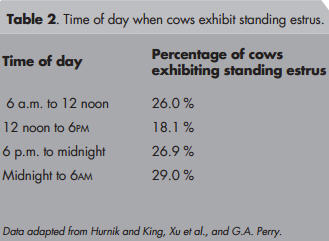Detecting Cows in Standing Estrus

For successful insemination of cattle to occur, animals must be detected in standing estrus, says George Perry, SDSU Extension Beef Reproductive Management Specialist.
"Detecting standing estrus, which is also referred to as heat detection or detecting standing heat, is simply looking for the changes in animal behavior associated with a cow/heifer standing to be mounted by a bull or another cow/heifer," he said.
Since cows not detected in estrus, and consequently not inseminated in artificial insemination (AI) programs, have no opportunity to conceive, Perry says heat detection becomes the single greatest limiting factor in managing beef cow reproductive programs.
"For successful artificial insemination of cattle to occur, the producer must take the place of the herd bull in detecting the cows/heifers that are ready to be inseminated," Perry said. "Accurate detection of animals in standing estrus is the goal of good estrous detection and plays a vital role in the success of any AI program."
He points to a Colorado State University study in which animals were administered an estrous synchronization protocol, then monitored for standing estrus 24-hours a day with a computer assisted estrus detection system (HeatWatch®) or twice a day for 30 minutes by visual observation. By day 5, after estrous synchronization, 95 percent of animals monitored 24-hours a day, were detected in standing estrous, while only 56 percent of animals observed twice a day for 30 minutes were detected in standing estrus.
With a 95 percent estrous detection rate and a 70 percent conception rate (95% X 70% = 67%), 67 percent of the animals will be pregnant; whereas, only a 39 percent (55% X 70% = 39%) pregnancy rate will occur with a 55 percent estrus detection rate - refer to table 1.
"Accurate detection of estrus can be a difficult and time-consuming activity," Perry said. "Continuous observation of over 500 animals exhibiting natural estrus in three separate studies indicated 55.9 percent of cows initiated standing estrus from 6 p.m. to 6 a.m. (refer to Table 2)," Perry said.
Based on research, Perry encourages producers to observe cows for estrus as often as possible. The research showed that when cows were observed for standing estrus every six hours (6 a.m., noon, 6 p.m., and midnight), estrous detection increased by 10 percent with the addition of a mid-day observation and by 19 percent when observed four times daily (every six hours) compared to detecting standing estrus at 6 a.m. and 6 p.m. alone.
"Therefore, detection of standing estrus can be one of the most time-consuming chores related to artificial insemination," he said.

Let the bulls do the work
With natural service, Perry says estrous detection is considered to be easy, as it is "the bulls' job." However, he says differences in estrous detection exist among bulls.
"Libido refers to a bull's desire to mate. Research from Kansas State has reported that Libido is highly inherited trait with heritability ranging as high as 0.59," he said. "This is because there is more variation in libido between sons of different sires than between sons of the same sire."
He reminds cattle producers that scrotal circumference, semen quality, and physical confirmation, all traits evaluated in a Breeding Soundness Evaluations, are not related to libido.
"Libido has a direct affect on pregnancy rate and, as such, it can influence the success of an entire breeding season," Perry said. "Libido can be practically evaluated by closely watching a bull after introducing him to a cow herd and determining his desire to detect cows in estrus."
Although several factors are critical to the success of any well-managed beef reproductive program, estrus detection is one of the most limiting and most time consuming. Without identifying cows in estrus, cows will not have an opportunity to conceive.
For more information related to detecting standing estrus contact, Jim Krantz, SDSU Extension Cow/Calf Field Specialist at jim.Krantz@sdstate.edu or 605-995-7381 or Dr. George Perry, SDSU Extension Beef Reproductive Management Specialist at george.perry@sdstate.edu or 605-688-5456. To listen to a recent iGrow Radio Network interview on this topic with Dr. George Perry, and to review all four articles in this four-part series released by SDSU Extension visit iGrow.org.








